Antonio da Sangallo il Giovane (Antonio Cordiani) was born in Florence. He trained as an architect under his maternal uncles, Giuliano da Sangallo and Antonio da Sangallo il Vecchio. He moved to Rome in 1504. He assisted first Bramante and then Raphael on the rebuilding of St Peter’s, becoming capomaestro after the death of the latter in 1520.
Antonio designed Palazzo Farnese for Cardinal Alessandro Farnese (see below) in 1517, but this project was interrupted by his work at St Peter’s from 1520. He seems to have escaped the trauma of the sack of Rome in 1527, and subsequently followed Pope Clement VII to Orvieto. In 1530-3, he took charge of the restoration of Santa Maria di Loreto, summoning a number of other (mostly Tuscan) sculptors as assistants. This group, which included Raffaello da Montelupo and Simone Mosca, subsequently retained its coherence. For example, when Bartolommeo Bandinelli abandoned the execution of the tombs of the Medici popes Leo X and Clement VII in Santa Maria sopra Minerva, Rome 1541, which Antonio had designed, Raffaello da Montelupo was retained to complete the work.
Faced with the continuing threat of warfare in Italy and of invasion by Turkish pirates, Antonio was used increasingly as a military engineer. For example, his designed two important fortresses in 1534: the Fortezza da Basso at Florence; and the fortress at Ancona.
After the election of Cardinal Farnese as Pope Paul III in 1534, Antonio redesigned Palazzo Farnese on a much grander scale. (It was completed by Michelangelo after his death). Paul III also employed Antonio as an engineer and military architect at Perugia (see below) and at the Farnese Duchy of Castro, as well as at Rome. The rebuilding of St Peter’s accelerated under Paul III, and Antonio’s wooden model (1539) for a new design for it survives there. He also designed the Sala Regia and the adjacent Cappella Paolina in the Vatican Palace at this time.
Paul III sent Antonio to open a new canal near the Cascata della Marmore in 1545 to address a chronic problem with flooding (see below). He died at nearby Terni, apparently from a fever that he contracted during this work.
Amelia
City Walls (1517-8)
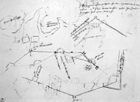
Palazzo Farrattini (ca. 1517)
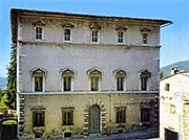
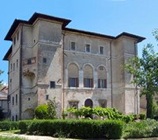
Images courtesy of Signor Ettore Farrattini Pojani
Bishop Bartolomeo II Farrattini, who commissioned Antonio da Sangallo il Giovane to design Palazzo Farrattini, is commemorated in the inscription:
UT MEMINERINT POSTERI BARTHOLOMEUM FARRATINUM
ALIQUANDO FUISSE EX LABORUM ET VIGILIARUM SUARUM
RELIQUIIS IPSE ET SUIS CASAM POSUIT
Bartolomeo II Farrattini was the Prefect of the Fabbrica di San Pietro in Rome and would have had close links with Antonio da Sangallo il Giovane, who (as noted above) became capomaestro there in 1520. The palace was first documented in his will of 1527.
Palazzo Farrattini is a scaled-down version of Antonio’s more famous Palazzo Farnese, which he had built for Cardinal Alessandro Farnese in Rome. (In fact, it probably reflects the original design (1517) for Palazzo Farnese, which was redesigned on a grander scale after Farnese’s election as Pope Paul III in 1534).
Antonio's original floor plan for Palazzo Farrattini survives in the Uffizi Gallery, Florence, although the design was simplified before construction. Giorgio Vasari described the resulting palace as "a beautiful and imposing work whereby Antonio [da Sangallo] acquired no little fame and profit". It must have made an enormous impression on Farrattini's more provincial neighbours.
The palace was built on the site of the Roman baths (1st century BC), most of which disappeared when it was built, although two black and white mosaic floors (2nd century AD) survive inside, some 4 meters below the present pavement level. These are connected to the subterranean cistern that is now on the opposite side of the road.
Città di Castello
Work at Palazzo Vitelli alla Cannoniera (ca. 1534)

The only record of the involvement of Antonio da Sangallo il Giovane at Palazzo Vitelli alla Cannoniera comes from Giorgio Vasari’s “Life” of Cristofano Gherardi, il Doceno. Vasari reports that Alessandro Vitelli sent him to Città di Castello, together with Antonio da Sangallo and Pier Francesco da Viterbo, to “repair the walls of the ... garden of Vitelli, which were threatening to fall down”, and that Cristofano Gherardi accompanied him. This was after Antonio da Sangallo and Pier Francesco da Viterbo had completed their work on the Fortezza da Basso (1534-7) in Florence.
It is clear from the rest of Vasari’s account that the walls in question included the garden facade of the palace. At the time of Antonio’s intervention, this comprised:
-
✴the original nucleus of the palace, at the end of the path in the photograph above; and
-
✴the five-bay extension immediately to the left of it, which had an open loggia on its ground floor. It is not clear whether this loggia was closed at the time of Antonio’s intervention or soon thereafter.
Foligno
Antonio da Sangallo il Giovane is documented at work on the remodelling of the Duomo in 1517-22. The work of designing a new right transept in order to achieve a Latin cross floor plan had been entrusted to in Cola da Caprarola 1512, but had met with structural problems. The surviving sketches by Antonio in the Uffizi Gallery, Florence depict:
-
✴the crossing, crypt and cupola of the Duomo; and
-
✴the lozenge-shaped Cappella del Corpus Domini (later Cappella Jacobilli), off the right wall of the left transept.
Antonio da Sangallo il Giovane was documented in Foligno in 1525, when he requested and was granted citizenship.
Orvieto
Antonio da Sangallo il Giovane occasionally visited Orvieto in 1513-4 to advise on the construction of the facade of the Duomo (see below).
As the events that led to the sack of Rome played out, Clement VII obviously saw that Orvieto might be needed as a place of refuge. He sent Antonio there on at least two occasions before the catastrophe:
-
✴His visit in 1525 seems to have concentrated on the poor water supply to to the city. He worked on the aqueduct at this time, although it was recognised that this structure would still be vulnerable to invading soldiers. He therefore looked for alternatives, and discovered three “sorgente” (natural water sources), which are documented in his subsequent drawing (1528) in the Uffizi Gallery, Florence:
-
•Sorgente di Santo Serio or Zero, where he built to Pozzo di San Patrizio (see below);
-
•Sorgente di San Manno, near Porta Postierla; and
-
•Sorgente del Leone, further below Porta Postierla.
-
✴His visit in 1526 addressed the city’s fortifications.
In March 1527, just two months before the sack of Rome, the Consiglio General made Antonio a citizen of Orvieto. It was at about this time that he began work on Pozzo della Cava (below).
The local historian, Pericle Perali records that Antonio built the cistern in Piazza del Popolo during the governorship of Antonio Ricasoli (1528-32). In 1532, the Commune gave him part of the Palazzo dei Sette along Via della Mercanzia on condition that he construct a palace there within 10 years. (In the event, he did not meet this condition and the site reverted to the Commune). They called him back to Orvieto in 1533, after the collapse of a large section of the city wall.
Antonio was present in Orvieto during the ceremonial visit to the city of Paul III, in September 1536. A record made at the time describes an temporary arch erected at this time to the design of “Antonio di S. Gallo, il quale habita qui” (who lives here). In fact, his other papal duties meant that he only occasionally returned to Orvieto after this time.
Work on the Duomo
Antonio left his mark on the Duomo over a period of nearly thirty years.
Facade (1513-33)
The Opera dell’ Duomo sent Michele Sanmicheli (capomaestro in 1509-25) to Rome in 1513 to consult Antonio da Sangallo il Giovane on the façade, and this seems to have led to occasional visits by Antonio to Orvieto in 1513-4.
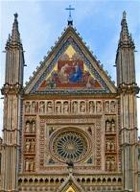
Design for the Altare dei Magi (1528)
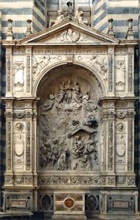
The Opera del Duomo commissioned a new design from Antonio da Sangallo the Younger: his design for part of the altar, which survives in the Uffizi Gallery, Florence, is annotated “per Santa Maria Orvieto, la cappella che cominciò el Verona [i.e. which Michele Sanmicheli had begun]”. Pope Clement VII, who took refuge in Orvieto in December 1527 after the sack of Rome, was asked to decide between the two designs and chose the former, although the side pilaster shown in Antonio da Sangallo’s design was used in the structure that was actually built.
Antonio da Sangallo arranged for Simone Mosca to take over the project in 1535. According the Giorgio Vasari, “there was summoned, at the suggestion of Simone, his very dear friend Raffaello da Montelupo” to work on the central relief under the arch. A document records that Simone Mosca acted as host to Antonio da Sangallo when he made a short visit in 1536 to introduce Raffaello da Montelupo to the authorities. The chapel was finally completed in 1546.
Work for Pope Paul III
Paul III commissioned a design from Antonio da Sangallo il Giovane for a new ceiling for the nave. The design survives in the Uffizi Gallery, Florence. Work on the ceiling began in 1538-40, but it was subsequently abandoned.

Piazza del Duomo
The area in front of the the facade of the Duomo (see Walk I) was cleared and levelled in 1556, apparently to a plan that had been made some decades earlier by Antonio da Sangallo il Giovane.
Pozzo della Cava (1527-30)

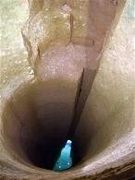
A letter discovered in 1999 reveals that Clement VII commissioned Antonio da Sangallo il Giovane to excavate a deep cylindrical borehole in what is now Via della Cava, which dated back to Etruscan times. (Some of the tufa that was extracted in the process was reserved Palazzo Pucci - see below).
The well was rediscovered in 1984, at which time its original depth of 30 meters had been reduced by 5 meters by rubble and refuse. A stone plaque exhibited in the museum records that it was closed in 1646, probably because of the fortification of Via della Cava during the War of Castro. [This plaque is of particular interest since it was carved on the back of an ancient relief that must have come from one of the city's ancient churches.]
The site was subsequently excavated to reveal a complex of caves dug out of the tufa that had been in use for various purposes since Etruscan times. The excavations were opened to the public as a private museum (the Museo del Pozzo della Cava) in 1996. The museum's excellent website provides a virtual tour round the fascinating caves.
The present wellhead (illustrated above) was installed in 2004, when the arch under which it had originally stood was re-opened.
Pozzo di San Patrizio (1527-37)
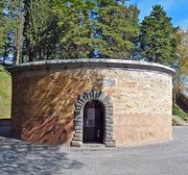
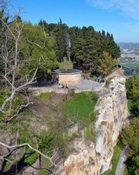
As noted above, Antonio di Sangallo il Giovane discovered the Sorgente di Santo Serio here in 1525. His work on what became known as the Pozzo di San Patrizio seems to have begun soon after Clement VII took refuge in Orvieto in December 1527. However, the first record of the project dates to 1530, when Clement VII (now back in Rome) wrote to the governor, Antonio Ricasoli authorising him to raise a new tax partly to pay for it. Excavations on this site were complete by early 1532 and the 30,000 bricks needed for the construction arrived in Orvieto in 1534.
Shortly afterwards, Clement VII commissioned Benvenuto Cellini to strike a commemorative medal, the obverse of which shows Moses striking a rock in the desert to provide water for the People of Israel. Cellini recounted in his "Autobiography":
"It was on a day in April [1534 ... Clement VII and I] talked a little on this subject: he praised my medals, and said they gave him the greatest satisfaction, but that he should like another reverse made according to a fancy of his own ... His Holiness then commissioned me to design the story of Moses when he strikes the rock and water issues from it, with this motto: Ut bibat populus [in order for the people to drink].
This medal, which is illustrated on a web page by John Paul Adams, is in the British Museum, London.
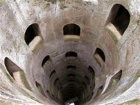
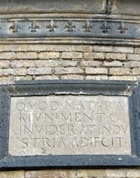
Etruscan artefacts found during the excavations for the well provided the first indication of the existence of the nearby Etruscan temple now known as the Tempio del Belvedere.
In the 19th century, the Servite monks from nearby Santa Maria dei Servi seem to have likened the well to the Purgatorio di San Patrizio (Purgatory of St Patrick). This was a cave on an island in Loch Derg in Ireland that St Patrick is thought to have discovered, which became a place of pilgrimage where pilgrims sometimes experienced visions of purgatory.
Design for Palazzo Pucci (ca. 1528)
The Florentine banker Raffaele Pucci commissioned Palazzo Pucci from Antonio da Sangallo il Giovane. As noted above, some of the tufa that was extracted during the excavation of the Pozzo della Cava was reserved for it. Antonio’s design survives in the Uffizi Gallery, Florence. The surrounding streets are identified in the design: the palace would have occupied a site of some 3,00 square meters, bounded by Corso Cavour, Via del Duomo, Via Signorelli and Via dei Cartari. It is not clear how much of it was ever built, but no securely identified remains survive.
Wellheads (ca. 1532)
The designs of two wellheads in Orvieto are attributed to Antonio da Sangallo il Giovane:
-
✴The wellhead in the cloister of San Giovanni Evangelista was probably built in or soon after 1532, when the canons of received money from the Commune for a cistern here.
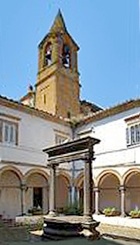
-
✴The wellhead in Piazza del Popolo, which bears the arms of Clement VII and the papal governor, Antonio Ricasoli (1528-32), is of similar design.
Design for Palazzo Comunale (1532)
Antonio da Sangallo il Giovane was commissioned to provide a model for a new public palace to replace the Palazzo Comunale in 1532. The project stalled until 1573, when Ippolito Scalza was commissioned to rebuild the palace according to this design. In fact, Scalza’s design, which survive in the Museo dell'Opera, seems to have been very much his own.
Palazzo Crispo Marsciano (ca. 1536-80)
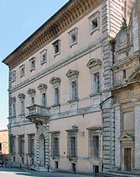
It seems likely that Raffaello da Montelupo, with whom he had close links, took over the project. However, the work proceeded intermittently, and the palace was still incomplete when both Cardinal Crispo and Raffaelo da Montelupo died in 1566.
Ludovico Marsciano bought the incomplete palace in 1582. The work he commissioned, which included the windows in the upper storeys, is attributed to Ippolito Scalza.
Palazzo Gualterio (16th century)
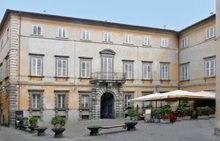
A design for Palazzo Gualterio by Antonio da Sangallo il Giovane survives in the Uffizi Gallery, Florence. It was probably built to this design by Simone Mosca: according to Giorgio Vasari, he “executed ... the ground plan and facade of the house of Messer Raffaello Gualtierio, father of the Bishop of Viterbo, and of Messer Felice, both noblemen and lords of great excellence and reputation”. (Raffaele and Felice Gualterio were respectively the son and nephew of Sebastiano Gualterio, who was bishop of Viterbo in the period 1551-66).
Perugia
Design of a new Sapienza (1520)
Cardinal Francesco Armellini commissioned this design from Antonio da Sangallo il Giovane for a new college in Piazza Sopramuro (later Piazza Matteotti - see Walk II). The designs survives in the Uffizi Gallery, Florence. The project was aborted after the death of Cardinal Armellini in 1527.
Rocca Paolina (1540-7)
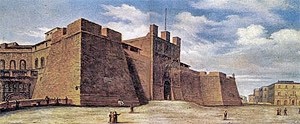
Facade of Rocca Paolina (after the filling in of the moat in ca. 1800)
Giuseppe Rossi, Galleria Nazionale
When the Perugians rebelled against Paul III in 1540 following the imposition of a tax on salt, Pier Luigi Farnese, the natural son of Paul III and commander of the papal army, took the city and ended the hegemony of the Baglioni family. He commissioned Antonio da Sangallo il Giovane to design a huge palace, incorporating the Baglioni palaces. This palace was carefully integrated into the existing urban environment, notwithstanding the fact that it entailed some demolition:
-
✴its west facade, on the site of the palace of Grifone and Malatesta Baglioni, opened onto the Piazza di Santa Maria dei Servi, the site of the important church of Santa Maria dei Servi; and
-
✴its east facade, on the site of the palace of Gentile Baglioni, respected the surviving remains of the Etruscan city walls, and incorporated Porta Marzia (see below) as its main portal.
This palace was linked by a fortified corridor to a new fortress, the Fortezza di San Cataldo, which was to act as a safe haven for the inhabitants of the new palace, in the way that the Castello di Sant' Angelo served the residents of the Palazzo Vaticano, Rome.
The foundation stone of the new palace was laid in November 1540. It seems likely that Pier Luigi Farnese intended it for his own use, but his attention soon moved to the more prestigious possibilities of Parma and Piacenza. His son, Ottavio Farnese, whom Paul III initially intended that should rule Perugia as "Perpetual Captain", visited the site in March 1541, and was apparently content. Its construction was largely complete by September 1541, when Paul III visited Perugia. However, he is reported to have said: "Questo non basta: voglio che vi si faccia una fortezza" (This is not enough: I want you to build a fortress). Whether or not this is true, it is certain that this change in design was subsequently made. It could have occurred after the assassination of Pier Luigi Farnese, which led to the elevation of Ottavio Farnese as Duke of Parma and Piacenza and hence his loss of interest in Perugia.
Under the new plan, the palace walls were replaced by the forbidding curtain walls of Rocca Paolina, complete with a moat. The original nine entrances were replaced by a single entrance to the north, which was protected by a drawbridge. The new project required the demolition of Santa Maria dei Servi and of a stretch of the Etruscan wall, including Porta Marzia (see below). The design of the Fortezza di San Cataldo was correspondingly reduced in scope.
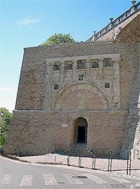
The major part of the fortress was demolished in 1860, almost as soon as Perugia became part of the newly-formed Kingdom of Italy.
Terni
Cascata della Marmore
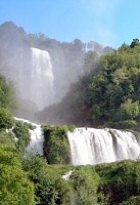
Palazzo Spada (1555-75)
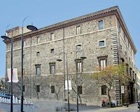
Palazzo Rosci (16th century)
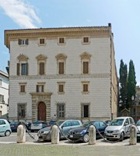
Todi
Advice on Tempio di Santa Maria della Consolazione (1532)
Antonio di Sangallo il Giovane was consulted in Orvieto in 1531 by the Fabbrica of the Tempio di Santa Maria della Consolazione, and travelled to Todi in 1532. A sketch by Antonio di Sangallo il Giovane, which survives in the Uffizi Gallery, Florence, relates to the construction of conventual buildings around the main apse of this church. This was associated with the decision in 1532 to cede the church to a community of Hieronymites (hermits of St Jerome) at Fiesole, but these plans came to nothing.
Palazzo Cesi (1546-7)
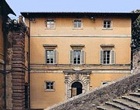
Three Cesi bishops lived in Palazzo Cesi:
-
✴Federico Cesi (1523-45, who became a cardinal in 1544 and died in 1565);
-
✴Giovanni Andrea Cesi (1545-66); and
-
✴Angelo Cesi (1566-1606).
It remained the property of the Cesi family until 1741. The inscription [over the portal] records the fact that it then passed to the poet Paolo Rolli, who translated the works of Milton into Italian.
The portal (ca. 1600), which was probably commissioned by Bishop Angelo Cesi, is attributed to Ippolito Scalza.
Read more:
R. Marta, “Antonio di Sangallo il Giovane: Architetto, Urbanista, Archeologo, Ingegnere”, (2007) Rome
L. Ricetti, “Antonio da Sangallo il Giovane in Orvieto: Una Lettura ed altri Documenti Inediti”, Mitteilungen des Kunsthistorischen Inst. Florenz, 42 (1998) 67-100
T. Verellen, “Patterns of Patronage: Antonio da Sangallo the Younger and the Setta of Sculptors”,
in F. Kent et al. (Eds), “Patronage, Art and Society in Renaissance Italy”, (1987) Oxford
Return to Art in: Amelia Città di Castello Foligno Orvieto Perugia Terni Todi.
Return to “Foreign” Architects in Umbria.



